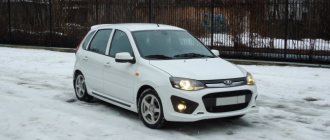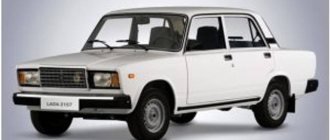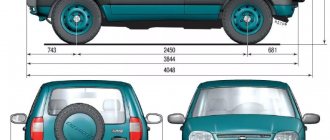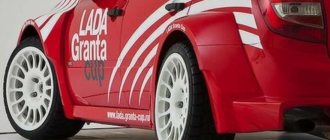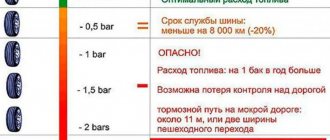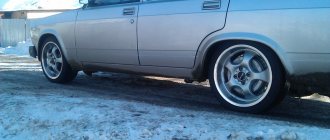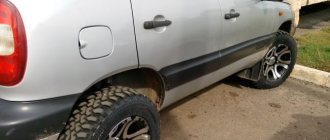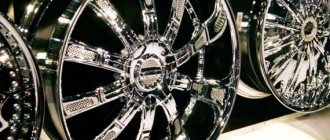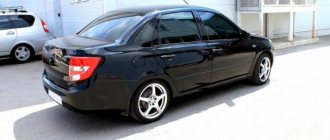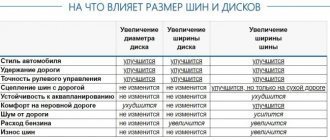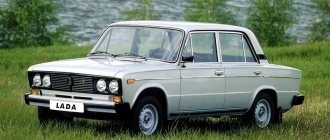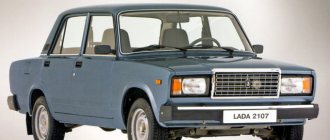Every Lada Kalina owner sooner or later faces the need to replace wheel rims. When you want to give the exterior of your “horse” a more attractive appearance, then you should take a closer look at the cast versions of the products. How practical is this? We will try to answer this question, which concerns a huge army of owners of products from the Russian automotive industry; it is also important to know that if you install other wheels, you will need a bolt pattern. We’ll also figure out what aspects you need to focus on when choosing, and what is the best tire size.
Acceptable sizes of tires and wheels VAZ 2192, 2194
The manufacturer indicated the tire and wheel sizes in the user manual.
On the “Standard” and “Norma” configurations, the manufacturer installs:
Rim width: 5 1/2J, disc offset (rim, ET): 35 mm, DIA: 58.5, bolt pattern: 4x98.
For the “Lux” package, the manufacturer installs:
- 175/65R14 82H
- 185/60R14 82H
- 185/55R15 82V
The factory installs the Lada Kalina 2 sport:
Standard tire sizes for Lada Kalina Cross:
R is not a radius, but a designation of the radius of the tire, and the number is the diameter of the rim in inches.
Rim width: 5J, 5 1/2J and 6J, disc offset (rim, ET): 35 mm, DIA: 58.5, bolt pattern: 4x98.
AvtoVAZ allows the installation of tires and wheels from one configuration of the Lada Kalina 2 to another and vice versa.
Recommended winter tire parameters
According to the manufacturer's recommendations, the Lada Kalina Cross is equipped exclusively with 15-inch wheels with the following parameters:
- Bolt pattern: 4x98;
- Departure: ET 32;
- Centering hole diameter: 58.6;
- Rim width: 6.0J.
Read:
AvtoVAZ allows the installation of tires with dimensions 195/55/R15 85H on these wheels without restrictions on the choice of specific manufacturers.
For Lada Kalina Cross
that are under warranty, you should select winter tires with the standard characteristics, otherwise service centers may refuse after-sales technical service. In addition, the design of the drives and steering, as well as the car’s suspension settings, are designed specifically for this wheel size.
Tire and Wheel Compatibility
Tuning enthusiasts are concerned about the question of what kind of alloy wheels can be installed on Kalina so that the wheels do not touch the fender liners and the speedometer does not lie. When choosing new “rollers”, take into account the full diameter of the wheel; it should not differ much from the standard one. You can understand which tires are suitable using the compatibility table. The left one is built on 185/60 R14 (minimum diameter), the right one - 185/55 R15 (maximum diameter):
Green indicates the minimum deviation of the wheel diameter (up to 3 mm); Orange indicates a diameter deviation from 3 to 6 mm.
Thus, you can install wheels on Lada Kalina 2:
- 175/70 R13, 185/70 R13, 195/65 R13, 205/60 R13, 215/60 R13, 225/55 R13;
- 175/65 R14 , 185/60 R14 , 195/60 R14, 205/55 R14, 225/50 R14;
- 175/55 R15, 185/55 R15 , 195/50 R15, 205/50 R15, 215/45 R15, 225/45 R15;
- 185/50 R16, 185/45 R16, 195/45 R16, 215/40 R16, 225/40 R16;
- 175/45 R17, 175/40 R17, 185/40 R17, 195/40 R17.
We advise you to choose only those tires that AvtoVAZ recommends (they are highlighted in bold in the list).
Don't forget about the rim width:
Lada Kalina. Largest wheel diameter.
Size 175/70. The tire profile height is 9 mm higher than the original one, the ground clearance is increased by 8.8 mm.
Narrow tires, due to higher surface pressure, provide increased stability on icy roads and reduce braking distances. Also, wheels with a narrow tread push through loose snow porridge faster, reaching the hard surface.
High profile winter tires
It is recommended for owners
of Kalina Cross
for driving on snow-covered roads; also, the increased tread profile will protect the rims from damage when hitting large obstacles (stones, curbs) that are not visible under the snow.
Read:
The main rule when choosing non-standard size tires for Kalina Cross is that the total wheel diameter remains constant (within 2%): as the tire width increases, you should choose models with a smaller height. Standard winter tires 195/55/R15 can be replaced with tires 205 mm wide, but with a lower profile: 205/50/R15.
In the same way, you can reduce the diameter of the wheels used: when replacing 15-inch wheels with 195/55/R15 tires on 14-inch wheels, winter tires of size 185/60/R14 (difference 0.05%) or 175/70/R14 ( discrepancy 0.43%). As a result, without negative consequences for the suspension and drives, the car is equipped for winter trips with higher-profile and narrower tires. You should not install winter tires with a diameter larger than the standard 15 inches, even if visually the wheel arches of Kalina Cross allow you to accommodate 17-inch wheels. With such tuning, the load on the struts increases, comfort when driving over uneven surfaces deteriorates, and when turning and large suspension strokes, the tires touch the wheel arches.
What does the size of tires and wheels affect?
Increasing disc diameter
| Increasing rim width | Increasing tire width | ||
| Car style | will improve | will improve | will improve |
| Road holding | will improve | will improve | will improve |
| Steering precision | will improve | will improve | will improve |
| Tire grip | Will not change | Will not change | will improve, but only on dry roads |
| Resistance to hydroplaning | Will not change | Will not change | will get worse |
| Comfort on rough roads | will get worse | Will not change | will improve |
| Road noise | Will not change | Will not change | will intensify |
| Gasoline consumption | Will not change | will increase | will increase |
| Tire wear | Will not change | Will not change | will increase |
Have you decided to choose winter tires for Lada Kalina 2? For winter it is recommended to choose narrow tires. The fact is that with such tires the pressure on the road surface will be greater, and therefore the grip on the road will improve. Wide tires are more sensitive to ruts in winter. Low-profile tires perfectly transfer even the smallest pits to the fifth point.
The smaller the unsprung masses
(this includes a lot of tires and wheels), the better the car will hold the road and accelerate faster. For example, if you put wheels on a car that are 2 kg lighter each, then acceleration to 100 km/h will be reduced by 0.2 seconds.
Attention! Installing larger wheels may lead to problems with ABS and ESC calibration (the systems may not work correctly).
Let us remind you that other instructions for modifying the new Kalina are in the tuning category or in the contents.
Source xn--80aal0a.xn--80asehdb
Lada Kalina owners often wonder what kind of wheels and tires are suitable for this car? In this case, the manufacturer provided an answer to this question and compiled a list of possible options for installing different wheel and tire options on Kalina. But the bolt pattern also plays a big role.
What is the tire pressure
Tire pressure must be monitored - and for different modifications of cars, depending on the load, this parameter can vary significantly. The pressure is also different for the front and rear axles.
The current pressure in the wheel can be measured using a pressure gauge - a special device. There are 3 different states of wheels on a Lada Kalina car:
- low – wide rubber contact patch, the disc can come into contact with the ground;
- overestimated – reduced contact patch with the road surface, the central part of the tread wears down an order of magnitude faster;
- normal pressure - the contact patch between the rubber and the road is normal, the tire wears evenly.
Comfortable and safe driving is possible at nominal pressure. The tire pressure ratings are indicated on a special plate attached to the door pillar. There are also other important data - wheel and tire sizes. This parameter differs slightly depending on the degree of load on the wheels.
For example, for tires 185/65 R14 86N the nominal values are as follows:
- partial load – 0.2 MPa;
- full load – 0.2 MPa.
For rubber of the same diameter and similar parameters, but with a 6.0 J 14H2 disc, the nominal pressure is the same - 0.2 MPa. Too low a pressure will cause the tread to wear unevenly across the center of the wheel. The nominal pressure parameters are identical for winter and summer tires.
Tire size on Kalina (factory)
According to the manufacturer's data, three tire sizes can be installed on the Lada Kalina. It depends on the year of manufacture of the car. So, let's look at what options exist for installing tires on the Lada Kalina:
- The most common size option is 175/70R13 . This is the standard size of “Zhiguli” tires, which takes its history back to the “Classics”.
- The second most popular size on a VAZ, but the most common on Lada Kalina is 175/65R14 .
Standard version of wheels for Lada Kalina in LUX configuration: 6.0×15 4*98 ET 35 dia58.6
All other tire size options are non-standard and are not recommended for installation on the Lada Kalina.
Visual table of tire applicability for Kalina
Visual table for selecting tire sizes for Lada Kalina
What disks are suitable as an alternative to the standard versions?
It's time to change the “original” wheels. The main thing here is not to overdo it, but to choose products that are as similar in design and geometric aspects as possible to the standard options. Note that the wheel parameters “don’t care” what body is in front of them (sedan or etc.).
To make the right selection, you will need to gain valuable knowledge such as:
- the quantitative composition of the holes for the mounting bolts and the diameter of the circle, the conditional line of which passes through the centers of the indicated holes (“LZ*PCD”, for Kalina - “4*98”);
- diameter of the central hole of the disk (“DIA”); for disks of this model it is equal to 58.6 mm (coincident with the hub diameter with tolerance);
- the offset value (or “ET”), which varies in values (to be specified later).
Let's summarize here.
1. The first generation of LADA Kalina in versions “1117”, “1118” and “1119” can be equipped with wheel versions from 13 to 16 inches with the following parameters:
- bolt pattern - 4*98;
- width – from 5 to 6.5 (inches);
- departure – from 25 to 35.
2. The second generation “2192” and “2194” will be content with wheels from 14 to 16 inches with the following characteristics:
- “LZ*PCD” similar parameter (4*98);
- width – from 5.5 to 6.5;
- offset: 25 – 35;
- the hole diameter is identical at 58.6 mm.
It should be remembered that correctly selected wheels will allow you to achieve traffic safety, moderate fuel consumption, and also increase the service life of the suspension.
Disk size
There are two options for installing disks on the Lada Kalina according to the technical documentation:
Wheel rim 5.5*14*98
Standard rim R15
Appearance on 15th wheels
To install other discs, you will have to replace some suspension and control parts.
Bolt pattern and possible options
Bolt pattern is the fastening of the wheel to the hub using bolts or special studs. Simply put, this is the size of a car's "shoe."
Wheel rim for Kalina with bolt pattern 4*98
For all generations of Lada Kalina, the bolt pattern is standard 4x98, although there were experiments when some cars came off the assembly line with a non-standard parameter - 4x100.
In order to change the wheel bolt pattern, you will have to turn to tuning and replacing some suspension elements. Such alterations are mainly carried out by tuning studios, since the selection of spare parts for the Lada Kalina is quite complicated. In this case, you will have to replace the hub, brake disc, steering knuckle, tie rod ends and shock absorber struts. We have already written in more detail about replacing front shock absorbers in this material.
Characteristics of wheels on Lada Kalina Cross
Starting in 2014, Russian engineers of the AvtoVAZ concern slightly adjusted the suspension of the Lada Kalina station wagon and they got a crossover, since the car was raised a few more centimeters above the ground. In addition, the necessary attributes for a small SUV were added to this version, and a fundamentally new car rolled off the assembly line - the Lada Kalina Cross. Of course, in order to match the qualities of the SUV, the car is equipped with slightly different rims.
In richer trim levels, the car is equipped with a slightly larger radius of wheels with parameters 6.5J x 15 ET30, and 195/55/R15 tires fit perfectly on them. This size is in high demand among buyers, as it is optimal for both smooth asphalt and off-road trails.
When purchasing a car, drivers try to choose exactly the modification that was initially equipped with alloy wheels from the K&K company, with 5 standard spokes in Silver color, because the caps on top of the stamped products often fly off and break when used on bad roads.
For those budget-conscious buyers, the most basic modifications come with stampings in both 14- and 15-inch radii, and they look pretty good when paired with branded plastic hubcaps.
Those same car enthusiasts who try to install R17 and higher wheels on this VAZ modification, with low-profile tires, taking advantage of the relatively high ground clearance, risk completely damaging the shock absorbers in the first year of operation of the vehicle. Thus, if the edge of the wheel extends too far relative to the axis of its attachment to the hub during maneuvers on the road, a significant load is placed on the mating element, which can cause deformation of the axle along with the brake disc, hub and studs, which will lead to their inevitable replacement.
standard sizes, steel and cast for different configurations
When it is necessary to replace disks on Kalina, the question arises, which ones to choose - the same factory ones or not. Die-cast ones often look more attractive and update the overall appearance of the car, but how practical is it? What should you pay attention to when choosing?
Return to contents
Characteristics of standard wheels of different configurations
The first generation Kalina models are equipped with 14 and 13 inch products. The light-alloy version was released with a diameter of R14. With this reduced tire profile, it is also possible to install R15 (this was done in the sports version).
For all modifications of the sedan, hatchback, station wagon, and sport models of the first generation, released in 2004–2013, the following dimensions were used:
- 5J wheels on 13 ET40, matching tires - 175/70R13;
- 5.5J on 14 ET37 - 175/65R14;
- 6J on 14 ET37 - 185/60R14;
- 6.5J on 15 ET35 - 195/50R15;
- 6.5J on 16 ET45 - 195/45R16.
All modifications of cars (hatchback, station wagon, cross, sports of the second generation (since 2014) were equipped with the following types of wheels and tires:
- 5.5J on 14 ET35, tires - 175/65R14;
- 6J on 14 ET35 - 185/60R14;
- 6J on 15 ET35 - 185/55R15;
- 6.5J on 15 ET35 - 195/50R15;
- 6.5J on 16 ET35 - 195/45R16.
The “norm” and “standard” packages of the second generation do not have factory alloy wheels. In the luxury package, the buyer can choose cast R14 and R15.
Return to contents
What disks can I replace the factory ones with?
When purchasing products other than those offered by the manufacturer, the radius of the wheel should be taken into account; it should not differ much from the standard one. It is necessary to take into account the year of manufacture of the car and its equipment. The wheel parameters are absolutely independent of the body shape: whether it is a sedan, hatchback or station wagon.
When selecting disks for Kalina, you need to know the number of mounting holes and the diameter of the circle for their placement (drilling, LZ*PCD) - 4*98. The diameter of the main hole should correspond to the vehicle hub diameter (DIA) - 58.6. The offset values (ET) must be selected as recommended by the car manufacturer. Thus, for the first generation models 1117, 1118, 1119, wheels from R13 to R16 inches are suitable; width 5–6.5; ET 25–38; DIA 58.6; LZ*PCD 4*98. For the second generation 2192 and 2194, the following parameters are suitable: R from 14 to 16; width from 5.5 to 6.5; ET from 25 to 35; DIA and LZ*PCD - similar.
Properly selected wheels for a Kalina car mean road safety, reduced fuel consumption, and extended transmission life.
Return to contents
Steel or light alloy: which is better and why
Based on the manufacturing method, models are divided into two types. Steel ones (also called stampings) are distinguished by the fact that during production all parts are welded. This is a simple technology, so their price is low. The positive aspects of this option: discs are easily restored even with deep deformations, they are highly reliable, durable, and repairs are simple and inexpensive. Negative aspects: difficulties with auto-balancing, increased weight, uniform appearance (it is possible to modify it with caps or paint), low corrosion resistance.
Light alloy products are modern and more popular; they include aluminum and magnesium alloys. According to the production method, they are divided into cast, forged, combined, and titanium.
| View | Manufacturing | pros | Minuses |
| Cast. | The metal is poured into molds, then the frozen surface is processed. This production method makes the metal structure grainy. | Low weight. | During long-term use on broken, bumpy roads, microcracks appear that can split the disc with a powerful impact. Repairs are expensive; products are straightened on a machine. But after such a procedure there is no guarantee of reliability during operation. |
| Forged. | Manufactured by hot stamping. The texture of the metal becomes fibrous and durable. | Low weight and high strength. | Forged wheels are produced from aluminum or magnesium (luxury quality, stronger than aluminum, the price is much higher, made by pre-order). |
| Combined. | Cast and forged parts are connected using special bolts. | They are subject to repair, and the rim can be replaced, but the central part can be left. | A considerable price, which provoked mass counterfeits - with decorative bolts. |
| Titanium. | Due to the large weight of the metal, the thickness of the disks is reduced during manufacturing. | The most durable. | They have a high price. A small number of models are produced. |
When choosing cast specimens, you should pay attention to the metal that is part of the alloy: magnesium - lighter in weight, but with reduced strength; aluminum - less susceptible to cracking. So which products are most suitable for Lada Kalina? Every driver strives for maximum safety on the road. When choosing wheels, you should analyze the condition of the surfaces on which the car will be driven and your driving style.
The advantages of steel wheels are their attractive cost. In addition, there is the possibility of restoration after deformation. When impacted, they do not split, but are crushed; suspension and steering parts are minimally damaged.
Alloy wheels for Kalina have such advantages.
- Wide range of different models. Additionally, there is the possibility of painting.
- Low weight increases the dynamic parameters of the suspension, which improves driving safety.
- Better performance of heat removal from brake units.
In Europe, alloy wheels are more popular. In the Russian market, due to the quality of roads, most drivers choose steel or forged ones.
17" casting machine
See what the Kalina-2 hatchback might look like on 17-inch wheels:
Kalina-2 on 17-inch casting, with and without lowering
There are two tuning options presented here, with and without lowering, and in both cases the wheels used are: 7Jx17 ET-38. Tires – 205/40 R17. According to the author of the first method, there are no problems as a result. That is, the wheels do not cling to the body anywhere even when the car is loaded. The only thing is that when you turn the steering wheel all the way, one of the wheels still slightly touches the metal, but this can be neglected.
You need to take into account the following: if you simply take and install wheels with 205/40 R17 tires, the seating position of the Kalina-2 hatchback or station wagon will increase to 175 mm (the standard value is 160 mm). In general, the next step should be a competently executed understatement. Author's version: the front suspension uses struts and springs shortened by 90 mm, the rear suspension is also equipped with shortened shock absorbers and springs (–90 mm). You don’t have to lower anything, but simply install new wheels, and this tuning method has been tested by owners in reality. But it is unlikely that a car with a seat height increased to 175 mm has better handling than the factory version. We will leave the choice to the owner.
Winter tires for viburnum
Which winter tires for Kalina are the best? Almost every owner of this car has similar questions. And the consumer market provides several options: you can save money by buying universal tires (the season change in them is done by simply moving the wheel), or you can pay a decent amount for a good set from a renowned manufacturer. Which option is better to go with?
Return to contents
Analysis of technical specifications
By default, Kalina is equipped with 13 and 14 inch wheels. Of course, they can be replaced with more massive ones without any problems, but we are talking about factory equipment. Acceptable sizes:
It is necessary to mention what functions winter tires perform and how they differ from summer tires. Its key difference is the rubber mixture itself and the freezing point. When driving a passenger car, the tires do not have an absolutely correct round shape. In this case, the skid would occur at every turn. The tire is slightly compressed, due to which the friction force increases and the car maintains a clearly defined trajectory. However, at temperatures of +5°C and below, summer tires become very hard and retain their round shape, which reduces the area of their contact with the road. The result is lower stability while driving.
Winter tires freeze at lower temperatures (about -20...-30°C). However, on hot asphalt it becomes very soft. It holds its trajectory well, but wears out literally after a few hundred kilometers. Based on all this, handling is affected by tire pressure, the load on each axle, and the total weight of the vehicle. Therefore, tires are selected with an emphasis on these characteristics, as well as on the driving style (but this is already a mediocre factor). So which tires are ideal for the Lada Kalina?
So, everything is clear with the sizes - they are static. But to ensure proper safety, you need to give preference to soft and medium-hard rubber, because the total weight of the car hardly exceeds 1.5 tons, which is only slightly higher than that of classic small cars. In turn, the tire pressure is maintained at 2.2 atmospheres for the front wheels, 2 for the rear wheels (without or with minimal load).
Wheel size is already a mediocre characteristic. Naturally, the larger the better, but you should not exceed 16 inches.
Return to contents
Choosing the best brand of winter tires
For Lada Kalina, 3 tire variations are installed from the factory. The best among them, according to reviews from those who have already used a car, are Nikon - tires from a famous Finnish manufacturer. This will be the optimal choice for any configuration of Kalina, be it with a diesel or gasoline engine up to a volume of 1.6 liters (only such variations are installed from the factory, but modification remains possible).
Winter tires like BridgeStone can be called higher quality and more reliable, but not rational in terms of cost. They are almost 3 times more expensive for a regular set of Nikon tires, but in practice they do not work out for their value. Still, it must be taken into account that the Lada Kalina will mainly be used on Russian roads in extremely harsh conditions. And here the use of too “delicate” rubber, for example, from the Nordman company, will not work (although there are several decent options there). Yes, it is reliable and of high quality, providing optimal control characteristics. However, as a consumer it is not the best option.
By the way, one thing that can be mentioned in favor of Nikon is that here the tire sizes for the same model vary over a wide range, so there will definitely not be any problems with the choice. But you shouldn’t buy universal tires that can act as both summer tires and winter tires. In practice, it has been repeatedly proven that under harsh operating conditions it wears out in literally 0.5 seasons. Therefore, saving is inappropriate here. Still, you should keep two sets of Kalina in your garage at once - for winter and summer. Rain is not necessary, since for a car of this class it has practically no advantages, and the hub still wears out unevenly for the most part due to numerous potholes on the roads.
If you don’t want to stop at Nikon, it’s better to pay attention to the Gislaved brand. Despite the fact that we are talking about Chinese production, its quality is not inferior to foreign analogues from Finland. Still, the “Made in China” label no longer indicates low quality products, and this is a fact.
And for those who prefer products in the mid-price category, we can offer winter tires from Nord: a fairly low price and resistance to dynamic loads allow the manufacturer to boast of the wear resistance of the rubber used. True, prices for these products have not been very encouraging lately, but this can only be explained by the jump in the ruble exchange rate.
What about taller tires? Larger tires can indeed improve a car's performance, but keep in mind that the wheel itself will be more vulnerable to aggressive driving, especially on broken asphalt.
Therefore, installing winter tires above R14 is recommended only for extremely careful drivers - only they will feel its benefits. The rest will be unhappy with the manufacturer, blaming the rapid wear of the tires, which is a mistake of the car owner himself.
We can also mention Kleber winter tires, but they are expensive. But they are very durable. They will easily withstand 4 seasons, maintaining the original tread pattern. But, according to reviews, they are prone to skidding at high speeds. Although this can be adjusted by tire pressure, there is no point in using them.
Recommendations
Comments 36
Gentlemen, can you tell me if 195/60/15 will fit?
Most likely they will rub.
Yes, they are nowhere else. My winter is 175/65/14, and my summer is 185/60/14. The discs from the previous owner were about equally dented. You need to drive more carefully.
185/65, not 60
They were on Libera 185/70/14, on diesel. Nothing broke through anywhere. I saw this size on a 12. There is a summer set for 185/65, I’ll put them on when these run out.
if you want it to not rub, go to 175/185 R13
No, 13 is not an option, because... 14 brakes are installed.
185/65 14 I just bought a summer one for myself. the car is higher from 185/60 by 1cm. but this is just not enough. doesn't rub
I drive 175/70 winter and summer. All OK. Doesn't stick anywhere.
I took this one for winter and I’ll take it for summer too. It goes smoother. But strokes are not a panacea, only prevention. Nothing catches, but the gaps remain 3-5 mm
A lot depends on the suspension, whether the struts break through or not
I would also add that 95% depends on the suspension. And on the quality of such an element as a compression buffer (simply - a bumper). On racks with standard settings, this is simply the first culprit for bumps on the wheels (with factory dimensions) ps For lovers of low profiles on bad roads, all this is not critical, they have their own truth.
I agree, while I’m riding on the SS20 there hasn’t been a single breakdown in 6 years, then one strut died over the summer 6 wheels on stock struts, the SS20 was repaired and again everything is fine, a little harsh, but I’m used to it
Well, I don’t have much respect for SS 20 and other popular brands, but the fact remains that suspensions designed for comfort mode do not protect the wheels and this needs to be understood.
I completely agree there is no comfort at all in city mode, but the wheels are intact and sharp
Well, everything is different. This is how I went:
Comfort tires are thin-walled, speed at the buzzer is 78 km/h. The holes are worse than they seem, the recorder “brightens up”, it’s spring—the holes with sharp edges are fresh.
So I’m saying that it’s not comfortable in the city, but on the highway it’s a pleasure
I felt comfortable everywhere)))
Well, if you drive at least 80, then everything will be normal
I put 185/65_14 even on the rear axle without spacers and it didn’t rub, the pressure was 2.2 ATM.
You need to drive more carefully and not engage in nonsense. 185/65/14 is not a standard size at all. With it, the car will noticeably lose in dynamics, control and braking. When I had 10, I ran 195/50/15 and never bent anything. Now I have a different car, I drive 205/45/17 and nothing catastrophic has happened yet.
A 195/50 are supposedly standard
